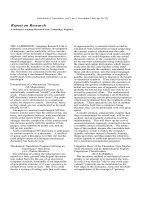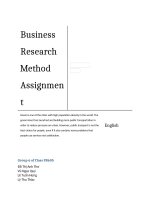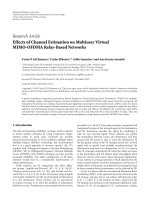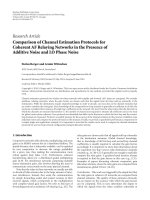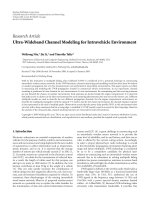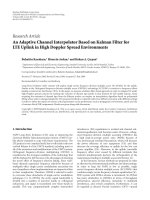REPORT SUBJECT RESEARCH METHOD TOPIC MICRO CHANNEL
Bạn đang xem bản rút gọn của tài liệu. Xem và tải ngay bản đầy đủ của tài liệu tại đây (269.24 KB, 12 trang )
MINISTRY OF EDUCATION AND TRAINING
HCMC UNIVERSITY OF TECHNOLOGY AND EDUCATION
REPORT
SUBJECT: RESEARCH METHOD
TOPIC: MICRO-CHANNEL
Lecturer: PhD. Dang Hung Son
Group 3:
DINH THE DUY
20147151
PHAN HOANG BUU
DAO QUOC DUY
LY TU CO
download by :
20147150
LECTURER REVIEW
………………………………………………………………………………………………
………………………………………………………………………………………………
………………………………………………………………………………………………
……………………………………………………………………………………………....
.……………………………………………………………………………………………...
………………………………………………………………………………………………
………………………………………………………………………………………………
………………………………………………………………………………………………
....
………………………………………………………………………………………………
………………………………………………………………………………………………
………………………………………………………………………………………………
……………………………………………………………………………………………....
………………………………………………………………………………………………
………………………………………………………………………………………………
………………………………………………………………………………………………
……………………………………………………………………………………………....
………………………………………………………………………………………………
………………………………………………………………………………………………
………………………………………………………………………………………………
……………………………………………………………………………………………....
………………………………………………………………………………………………
………………………………………………………………………………………………
………………………………………………………………………………………………
……………………………………………………………………………………………....
………………………………………………………………………………………………
………………………………………………………………………………………………
………………………………………………………………………………………………
……………………………………………………………………………………………....
………………………………………………………………………………………………
………………………………………………………………………………………………
………………………………………………………………………………………………
……………………………………………………………………………………………....
………………………………………………………………………………………………
………………………………………………………………………………………………
………………………………………………………………………………………………
…………………………………………………………………………………
download by :
TABLE OF ASSIGNED WORK
Work
No.
Name
ID
Word
PowerPoint
1
Đinh Thế Duy
Abstract, Introduction
Abstract, Introduction
2
Phan Hoàng Bửu
Problem statement
Problem statement
Đào Quốc Duy
3
4
20147150
Lý Tự Cơ
20116016
Theoretical approach
(page7,8), Conclusions
(page 11)
Theoretical approach
(slide:8-13), Conclusions
(slide 22)
Case studies ( slide 15Case studies ( page 6-8 )
20 )
download by :
HEAT TRANSFER SIMULATION FOR THERMAL
MANAGEMENT OF ELECTRONIC COMPONENTS
Đinh Thế Duy Phan Hoàng Bửu Đào Quốc Duy Lý Tự Cơ
Ho Chi Minh City University of Technology and Education Viet Nam
Faculty of High Quality, No 1 Vo Van Ngan Street, Linh Chieu Ward, Thu Duc District,
Ho Chi Minh City, Vietnam.
ABSTRACT
This research is to introduce the electronics design workflow and show the problem of
heat transfer for electronic devices. Physical, economic, environmental, ergonomic or
performance issue all have a big influence on heat transfer. Engineering knowledge
achievements and their relationship with a PLM platform are schematically discussed.
The most common heat transfer solvers and the peculiarities for the electronic are
presented. The concept of athesehis is presented through two examples. First, an example
of natural convection transfer for a heat sink. The second study was an experimental
forced-convection steady-state cooling setup. Experimental results will be presented in
the report
Keywords: Electronics, design, cooling, heat transfer, knowledge, FEM, CFD.
download by :
1. Introduction
The mechanism of heat transfer in electronics is very complex. The multi-physics aspect
can be divided into three domains: the electric domain, the thermal domain, and the fluid
one. Heat is generated in most electronic components. devices with moderate cooling
capacity are cooled by fans. liquid can also be used to cool them. It is necessary to take
care of the temperature of electronic devices to prolong their life and performance.
Products are getting smaller and smaller, demand is increasing, manufacturer standards
are constantly improving, and manufacturers have to keep up the pace. Radiator with heat
pipe combination. Heat sinks that combine heat pipes, micro-channels with highly
thermally conductive materials can replace conventional coolers. The economical aspect
can turn into concern as the final products become expensive and their manufacturers are
no longer competitive. All design decisions for an electronic device are made only after
the cooling problem for that device has been resolved. Therefore, heat transfer is a very
important issue in the design of electronic components.
Numerical 3D optimization of a heat sink base, Computational Fluid Dynamic (CFD),
combining numerical and analytical temperature approximation. All these papers describe
specific solutions for particular cases. Important product information and the relationship
with Product Life Cycle Management (PLM) solutions are also discussed. These
examples contain theoretical and experimental solutions that prove the accuracy of the
presented concepts.
2. Problem statement
In the field of electronics, competitiveness is a key factor to assure an optimal product
price in respect to actual standards. Design engineers face multiple challenges in order to
take the right decisions. Optimal electronics are designed with the least number of
components, placed on an optimal Printed Circuit Board (PCB) layout and assembled in
an ergonomic casing. The engineering knowledge is stored at PLM level and used further
to automate simulation tasks, reuse models and share results. The conceptual design is
tested using Electronic Design Automation software. The exterior and interior 3D
assembly is completed by means of Computer Aided Design (CAD) software. Optimal
thermal assessments require a combination of analytical solutions, empirical analysis and
thermal modeling, using all available tools to support each other. A wide range of heat
transfer solvers are available. Thus, numerical solutions are more common because
complex parameters are not required.
Two types of commercial numerical heat transfer solvers are available: the Finite
Element Method (FEM) and the CFD solver.
2.1. FEM Solvers
Thermal analysis is used to determine the temperature distribution and the other heat
transfer computations in a body:
download by :
the quantity of heat exchanged, thermal gradient and heat flux. As the structural response
is influenced by the thermal field, coupled thermal-structural analysis are performed to
describe the stress state due to thermal expansion or contraction.
In structural FEM based software, heat is transferred by conduction, convection or
through radiation.
The major disadvantage of the FEM thermal analysis is the size of the model and the
computation time.
2.2. Computational Fluid Dynamics
Simulating real flow by numerical solutions of the governing equations. Thermal
management can be simulated using the CFD.
Solvers instead of approximating convection film coefficients as FEM software
The major advantage on the FEM solution is the dedicated CFD pre and postprocessors
available for electronics.
Simulation capabilities are expanded due to extended material libraries, components and
Integrated Circuit (IC) package databases, multi-layer PCB configurators, thermal
interface materials and others.
2.3. Electronic Design Automation
The circuit diagram of the assembly is created using Electronic Design. Automation
software for circuit evaluation and simulation purposes in the electrical domain.
The behavior of the current is captured and its transient flow can be described allowing
all heat data to be estimated.
3D CAD files independent or with the use of third-party tools, such as macros and addons.
2.4. Heat Transfer Calculator
The behavior of the electronic components can be used to compute 2D surface heat flow
on 3D internal heat generation for components and printed circuits. Due to the
complexity of the heat flow mechanism in electronics (i.e. switching circuits, power
losses, thermal characteristics, junction temperature, joule heating) a complete physic
description is still not available. Therefore, methods of computing thermal
characterization parameters are based on simplified assumptions a.
2.5. Computer Aided Design
Not all Electronic Design Automation applications have CAD generation features or
extended component libraries (i.e. complex heat sinks, heat pipes, blowers, fans, specific
connectors).Therefore, in order to complete the product assembly, a CAD system is
required.
A final layout is proposed, than minor design changes are considered.
For example, passive components can be placed in the vicinity of active components to
act as heat exchangers. Also, small heat sinks can be positioned on the PCB under the
download by :
active components, to enhance the thermal behavior around hot spots .This is only a
preliminary design scenario where the 3D assembly is parameterized.
2.6. Heat Transfer Solvers
Heat transfer solvers are used to predict the temperature of the components and parts
within an assembly. The central role of the heat transfer code capability of such software
to identify any issues. Both hot spots within the PCB temperature distributions that
exceed operational limits can be visualized. The choice of the heat ware ranges from
simple analytical code numerical solvers. Results from the heat transfer to decide if the
design is optimal or an optimization scenario has to be considered .The concern of
electronics heat transfer computer is that of the active components and their cooling
components (resistors, transistors, integrated circuits transformers).
3. Theoretical approach
The equations for conductive heat transfer are described by:
where
represents the specific heat matrix,
time derivative of the nodal
temperatures,
- thermal conductivity matrix, and
- the effective nodal heat flow
vector. The primary unknown values are the nodal temperatures. Other thermal
parameters can be computed based on the nodal temperatures. There are two types of
FEM thermal analysis: steady-state and transient thermal analysis.
3.1. Steady-state thermal analysis
Steady-state thermal analysis is used to determine the temperature distribution in a
structure at thermal equilibrium. Steady-state solvers assume that the loaded body
instantaneously develops an internal field variable distribution to equilibrate the applied
loads. The analysis is generally non-linear because the material properties are
temperature dependent. The governing equations for a non-linear regime are:
where i represents the iteration step number. The first iteration is used to solve the initial
temperature conditions and the solution proceeds to the next iteration until the result
convergence is achieved. The necessary number of iterations for a precise solution
depends on the non-linearity of the problem. For solving the non-linear problem NewtonRaphson algorithm is used.
3.2. Transient thermal analysis
This type of analysis is used to determine the temperature distribution within a structure
as a function of time, to distribution within a structure as a function of time, to predict the
rates of the heat transfer, or the heat stored in the system. The transient thermal analysis
download by :
assumes the evolution of a new field variable distribution from a set of initial conditions
via a set of transition states, evolving through time. Because most of the thermal
phenomena have a transient evolution, this is the most common type of thermal
simulation. Material properties for a transient thermal analysis are: the density, the
thermal conductivity and the specific heat. The last characteristic is used to consider the
effect of the stored heat:
where:
is the specific heat matrix and
matrix of the thermal conductivity.
Loads are functions of time. The effects of numerical integration are activated using the
Crank-Nicholson, Euler and Galerkin or Backward stiffness methods. When the solution
is done, post-processing of the temperature evolution in time can be presented as tables,
graphs or contour plots.
3.3. CFD thermal analysis
The CFD (Computational Fluid Dynamics) simulation solves the conservation equations
for mass and momentum. For flows involving heat transfer, an additional equation for
energy conservation is required
The equation for mass conservation, or the continuity equation, can be written in a
general form as follows :
where
is the fluid density,
- speed vector, and
source mass.
The conservation of momentum in an inertial reference frame is described by
where
is the static pressure,
external body forces. Also,
stress tensor,
gravitational body force, and
-
contains other model-dependent source terms.
The stress tensor is given by
where is the molecular viscosity, I - unit tensor, and the second term on the right hand
side represents the effect of volume dilation.
For the heat transfer, the energy equation is solved in the following form:
download by :
where
is the effective conductivity,
is the turbulent thermal
conductivity, defined according to the turbulence used model, and
- the diffusion flux
of species. The first three terms on the right-hand side of Eq. represent the energy
transfer due to conduction species diffusion, and viscous dissipation, respectively
includes any other volumetric heat sources. Additional transport equations are also solved
for turbulent flow.
4, CASE STUDIES
4.1 Transient Thermal Analysis for Heat Sink performance evaluation
In this first example, the transient temperature behavior of natural convection cooled
electronics was simulated using a FEM transient thermal analysis.
4.1.1 Simulation model setup: The model comprises a single layer FR-4
Epoxy board that has been attached two IC silicon based chips, cooled by
natural convection using a fined aluminum alloy heat sink this simulation
is to study the temperature distribution within the heat sink for a transient
heat flow, such performance of the cooling solution can be evaluated.
The simulation requires the definition of three domains: electrical
domain (current flow constraints within the circuit), thermal domain
(heat generated due to the cu rent flow) and fluid domain (stagnant air
heat transfer between the heat sink and the exterior). The simulation
domains and parameters are described in the below.
Fig. 3. Non-linear IC heat cycles used in the simulation
Domain
Thermal
domain
Fluid
domain
Results
Parameters
Active component heat
flow [W]
Reference
temperature
[°C]
Stagnant air natural
convection cases [W/m2°C]
Transient nodal
temperatures [°C]
Non-linear
(Fig. 3)
22
7.151
(Fig. 5)
Fig. 3. Non-linear IC heat cycles used in the simulation
Fig. 4. Heat sink temperature distribution
download by :
4.1.2 Results and discussions: After completing the solution, time-temperature
distributions graph (Fig. 4) and the nodal temperatures for certain analysis time steps
were processed to evaluate the performance of the heat sink. The time-temperature
graph shows three distinct regions: a linear temperature growth region and two
parabolic ones, that describe the response of the heat sink after conduction is achieved.
The temperature non-uniformity is clearly depicted as the heat remains
concentrated at the bottom face of the heat sink, while the fins remain essentially at
the reference temperature.
4.2 Steady State forced convection cooling analysis
First of all, general remarks have to be done regarding Figure 4. In most cases, the
heat flow of the active electronic components is non-linear. However, due to the
specific heat of each material found in the path of the thermal conduction, a steady-state
temperature will be achieved for the non-linear heat flow that has a constant behavior in
time. Solving the transient CFD heat transfer problem can generate a black-box
behavior of the product. Further, specific convergence guidelines for transient CFD
problems are not available, because the accuracy of the results relays most on the
experience of the analyst. Moreover, solver output files become large and the time
required to achieve a solution increases dramatically.
4.2.1 Simulation model setup: In this second study ANSYS ICEPAK pre and post
processors, together with ANSYS FLUENT were used to simulate a steady-state forced
convection cooling problem. The active components were two MOSFETS installed on
two aluminum heat sinks with horizontal fins (Fig. 6). An exterior circuit comprising
four resistors for each MOSFET caused the active components to generate a constant
level of heat. Cooling is achieved by an axially
Installed fan as the air flows from the case back (called inlet) to the front (outlet). Two
precision LM-35 temperature sensors were installed in different positions on the heat
sinks and using an external micro-controller, the temperature was measured considering
the time increment, until the steady-state temperate is achieved
The experiment took place in three stages:
1. circuit power ‒ ON;
2. transient temperature monitoring;
3. ////Steady state temperature achieved.
Probe
Experimental steady state
CFD
Error ‒
download by :
Experimental and simulation values
temperature (°C)
T1
T2
36.1°C
41.9°C
steady state temperature (°C)
36.207°C
41.36°C
experimental vs.
simulation
temperatures
0.27%
1.45%
Results and discussions: The processed results were the temperatures of
the components and the pressure. In order to check the accuracy of the results,
experiments were performed to determine the steady-state temperature (Fig. 14). The
evolution of the transient temperature during time was read by connecting two
temperature sensors to an external Data Acquisition Board. Using a PC and
MATLAB software, a code was written to read the temperature from the sensors
(Fig. 15). The experiment ended when the steady-state temperatures were reached.
Both and sensors were monitored. These temperatures were compared with the
corresponding values of two temperature probes, placed in the CFD model at the
same coordinates, matching the surface contact be- tween the heat sink and the
sensor.
A good fit between the simulation results and the experimental ones, with an
acceptable error has been found. Results and errors are detailed in Table 3.
Experimental time-temperature graphs and CFD simulation temperature probes are
presented
1.2.2.
References
5. Conclusions
Advanced modelling techniques and new simulation strategies were presented for the
heat transfer analysis of the electronic components. The multi-physics simulation
procedures were employed in conjunction with circuit evaluation software in an original
approach. The work- flows ensured efficient model preparation stages and fast
verification of the results. The research had an extended literature overview, as well as a
large theoretical back- ground. A comparison between Finite Element Method and
Computational Fluid Dynamics heat transfer procedures was also included.
The thermal management was defined and explained from an integrated PLM point of
view, where Electronics Design Automation, Computer Aided Design and Heat Transfer
Calculators concepts were developed. The two case studies proved the efficiency and the
accuracy of the proposed techniques. Data acquisition tools were used and original
MATLAB codes were deployed. Parameters defined and monitored during the
experiments were explained and illustrating graphs were provided.
Further work will focus on design optimization based on all simulation strategies
discussed, to re- duce expensive material consumption and to find a trade-off between
environmental demands, price and product performances, that can be satisfied in respect
to the actual standards.
download by :
This paper does not only highlight the experimental or simulation procedures, but it is an
integrated approach for describing the multi-physics of electronics heat transfer.
The novelty of the research consists in the use of integrated simulation tools, tuned with
experimental methods that support the workflow.
6. References
[1] Freescale Semiconductor Inc., Thermal Analysis of Semiconductor Systems, available
at: papep/BasicThermalWP.pdf, accessed:
2016-02-01.
[2] W.C. Leong, M.Z. Abdullah, C.Y. Khor and H.J. TAN, FSI Study of the effect of air
inlet/outlet arrangement on the reliability and cooling performances of flexible printed
circuit board electronics, Journal of Thermal Science and Technology, Vol. 33, No. 1,
2013, pp. 43‒53.
[3] P. Singhala, D.N. Shah and B. Patel, Temperature Control using Fuzzy Logic,
International Journal of Instrumentation and Control Systems (IJICS), Vol. 4, No. 1,
2014, pp. 1‒10.
[4] G. Sharon, Temperature Cycling and Fatigue in Electronics,
accessed: 2016-04-01.
[5] S. Satyanarayan S., S. Zade, S. Sitre S. and P. Meshram, A Text Book of
Environmental Studies (As per UGC Syllabus), Allied Publishers PVT. LTD., New
Delhi, 2009.
[6] J. Li and S. Zhong-Shan, 3D numerical optimization of a heat sink base for
electronics cooling, International Com- munications in Heat and Mass Transfer, Vol. 39,
No.2, 2012, pp. 204-208.
[7] J.N. Davidson, D.A. Stone, M.P. Foster and D.T. Gladwin, Real - Time Temperature
Estimation in a Multiple Device Power Electronics System Subjected to Dynamic
Cooling, IEEE Transactions in Power Electronics, Vol. 31, No. 4, 2016, pp. 2709‒2719.
[8] Morgan Advanced Materials, Web Based Heat Transfer Calculator, available at
http://morganhea- tflow.com/Account/Login?ReturnUrl=%2f, ac- cessed: 2016-01-15.
[9] S. Rzepka, F. Krämer, O. Grassmé, and J. Lienig, A multi- layer PCB material
modeling approach based on laminate theory, Thermal, Mechanical and Multi-Physics
Simula- tion and Experiments in Microelectronics and Micro- Systems, edited by G.Q.
Zhang, Freiburg-im-Breisgau, Germany, April 2008, pp. 234‒243.
download by :

